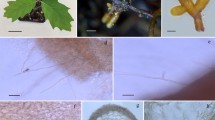Abstract
Based on an assessment of soil and climatic conditions in British Columbia (BC), the Truffle Association of British Columbia (TABC) determined that the cultivation of Mediterranean Tuber melanosporum and Tuber aestivum might be possible in the warmer parts of the province. With the cooperation of independent truffle growers, TABC assessed the colonization of host tree roots collected from eight truffle orchards planted 2–7 years earlier using morphological and molecular criteria. Both Tuber species persisted on the roots of inoculated trees in six of the eight truffle orchards studied. The identity of Tuber ectomycorrhizas that had been characterized morphologically as differing from those of T. melanosporum and T. aestivum were determined using DNA sequence analysis to belong to three species of truffles native to the Pacific Northwest. One of those species, Tuber anniae, had been previously reported from BC, but the other two, Tuber menseri nom. prov. and Tuber beyerlei, are reported here from BC for the first time. Recently, production of three Périgord black truffles in one truffle orchard and one Burgundy truffle in another orchard demonstrates that these truffles are able to fruit in BC.

Similar content being viewed by others
References
Agerer R ed (1987–2002) Colour atlas of ectomycorrhizae, 1st–12th del., Einhorn-Verlag, Schwäbisch Gmünd ISBN: 3-921703-77-8
Australian Truffle Growers’ Association (2011) Science helping Australia produce some of the world’s best quality truffles. http://www.trufflegrowers.com.au/wp-content/uploads/2011/06/Winter-Truffle-Press-Release-170611.pdf
Berch, SM (2013) Truffle cultivation and commercially harvested native truffles. In: Proceedings of international symposium on forest mushroom. Hosted by Korea Forest Research Institute and Korean Forest Mushroom Society. August 6, 2013, Seoul, Republic of Korea. Pp. 85–97. http://www.for.gov.bc.ca/hfd/pubs/docs/scv/SCV872.pdf
Bonito GM, Gryganskyi AP, Trappe JM, Vilgalys R (2010) A global meta-analysis of Tuber ITS rDNA sequences: species diversity, host associations and long-distance dispersal. Mol Ecol 19:4994–5008. doi:10.111/j.1365-294.2010.04855.x
Commonwealth of Australia (2013) ICON database, Department of Agriculture, Fisheries, Forests, accessed September 12, 2013
Edgar RC (2004) MUSCLE: a multiple sequence alignment method with reduced time and space complexity. BMC Bioinforma 5:1–19. doi:10.1186/1471-2105-5-113
Fischer C, Colinas C (1996) Methodology for certification of Quercus ilex seedlings inoculated with Tuber melanosporum for commercial application. In: Proceedings of the 1st international conference on mycorrhizae. Berkeley, CA, USA
Guerin-Laguette A, Cummings N, Hesom-Williams N, Butler R, Wang Y (2013) Mycorrhiza analyses in New Zealand truffières reveal frequent but variable persistence of Tuber melanosporum in co-existence with other truffle species. Mycorrhiza 23:87–98. doi:10.1007/s00572-012-0450-2
Guevara G, Bonito G, Trappe JM, Cazares E, Williams G, Healy RA, Schadt C, Vilgalys R (2013) New North American truffles (Tuber spp.) and their ectomycorrhizal associations. Mycologia 105(1):194–209. doi:10.3852/12-087
Hall IR, Brown G (2002) The black truffle: its history, uses and cultivation. Reprint of second edition on CD ROM plus booklet. New Zealand Institute for Crop & Food Research Limited, Christchurch
Hall IR, Brown GT, Zambonelli A (2007) Taming the truffle. The history, lore, and science of the ultimate mushroom. Timber, Portland, p 305
Hall IR, Frith A, Haslam W (2008) A rough climatic comparison of various centres adjacent to or with similar climates to Périgord black, Italian white, Burgundy and bianchetto truffle producing areas. Dunedin, Truffles & Mushrooms (Consulting) Ltd. (updated 19 October 2013). www.trufflesandmushrooms.co.nz/free%20downloads.html, accessed January 2014
Huelsenbeck JP, Ronquist F (2001) MrBayes: Bayesian inference of phylogeneric trees. Bioinforma 17:754–755. doi:10.1093/bioinformatics/17.8.754
Lefevre C (2012) Native and cultivated truffles of North America. Chapter 12 in Edible Ectomycorrhizal Mushrooms, edited by Zambonelli A and Bonito G. Soil Biol 34:209–226
Linde CC, Selmes H (2012) Genetic diversity and mating type distribution of Tuber melanosporum and their significance to truffle cultivation in artificially planted truffières in Australia. Appl Environ Microbiol 78(18):6534–6539
Maddison WP, Maddison DR (2009) Mesquite 2.6: a modular system for evolutionary analysis. Periodical mesquite: a modular system for evolutionary analysis. http://mesquiteproject.org
New Zealand Ministry of Agriculture and Forestry (2003) (amended 2011) Importation into New Zealand of specified fresh and frozen Tuber species (truffles). Biosecurity New Zealand Standard BNZ-IMP-TUBER. http://www.biosecurity.govt.nz/files/ihs/bnz-imp-tuber.pdf
Rubini A, Belfiori B, Passeri V, Baciarelli Falini L, Arcioni S, Riccioni C, Paolocci F (2011) The AD-type ectomycorrhizas, one of the most common morphotypes present in truffle fields, result from fungi belonging to the Trichophaea woolhopeia species complex. Mycorrhiza 21(1):17–25
Swofford DL (2002) PAUP* 4.0: phylogenetic analysis using parsimony (*and other methods). Sunderland, Massachusetts: Sinauer Associates
Zambonelli A, Iotti M, Boutahir S, Lancellotti E, Perini C, Pacioni G (2012) Ectomycorrhizal fungal communities of edible ectomycorrhizal mushrooms. Chapter 7 in edible ectomycorrhizal mushrooms, edited by Zambonelli A and Bonito G. Soil Biol 34:105–124
Acknowledgments
We are grateful to the Agroforestry Development Initiative Fund for funding this research, to all of the truffle growers who participated in this study, and to Charles Lefevre of New World Truffières for supporting this work with advice on truffle cultivation and root sampling. Special thanks go to Wayne Haddow, BC Ministry of Agriculture, for being one of the first people in BC to see the possibility of a Mediterranean truffle industry in British Columbia. The Fragment Analysis and DNA Sequencing Services (FADSS) at the University of British Columbia-Okanagan carried out the PCR amplification and sequencing of ectomycorrhizas. Dr. Mary Berbee, University of British Columbia, sequenced the Tuber melanosporum and Tuber aestivum truffles produced in BC. Gregory Bonito was supported through the US Department of Energy, Office of Biological and Environmental Research, Genome Science Program.
Author information
Authors and Affiliations
Corresponding author
Rights and permissions
About this article
Cite this article
Berch, S.M., Bonito, G. Cultivation of Mediterranean species of Tuber (Tuberaceae) in British Columbia, Canada. Mycorrhiza 24, 473–479 (2014). https://doi.org/10.1007/s00572-014-0562-y
Received:
Accepted:
Published:
Issue Date:
DOI: https://doi.org/10.1007/s00572-014-0562-y



